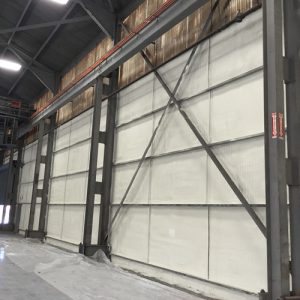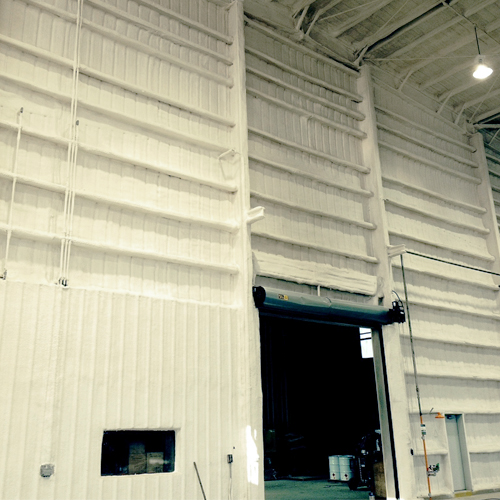With building code compliance and sustainable building envelopes at the forefront in today’s marketplace, spray polyurethane foam insulation (SPF) applied to single skin metal roof and wall panels is an alternative to insulated metal panels with a manufacture-applied polyurethane foam core. SPF insulation improves a building’s energy efficiency and provides thermal, air and vapor barrier capabilities.
What Is Spray Polyurethane Foam (SPF) Insulation?
SPF insulation consists of isocyanate and polyol resin that is chemically combined and applied to surfaces using a spray gun. SPF insulation can be open cell or closed cell. Open-cell foam provides insulation and air sealing for a building, but is water and vapor permeable. Closed-cell foam provides better insulation than open cell and also functions as an air barrier. Closed-cell foam differs from open cell in that it prevents water entry, minimizes moisture vapor permeability and decreases air leakage, making it the preferred insulation to apply to metal panels.

SPF insulation is well suited for use as interior insulation for metal wall and through-fastened metal roof panels. The traditional thermal insulation layer—one or two layers of batt insulation with a facer—has its intricacies; for example, compressed areas and difficulty taping seams at edges and penetrations for air barrier performance. But because of SPF’s inherent physical characteristics and spray application method, SPF overcomes many obstacles.
8 Application and Safety Tips for SPF
Using SPF to fully insulate and seal a building with metal panels can have unintended consequences if the material characteristics and project parameters are not well thought out. The Metal Construction Association (MCA) recently conducted research with the Spray Polyurethane Foam Alliance (SPFA) and published their findings in a technical bulletin. It includes the following best practices and considerations for installing SPF.

- Utilize a certified foam spray technician to ensure the insulation meets the desired thickness, density and adhesion.
- Only apply SPF to clean, dry areas.
- SPF should not be used on standing seam metal roof panels because it may restrict the thermal movement of the panels, causing distortion.
- Follow a “picture frame” application technique, further detailed here, to prevent SPF from getting between girts and metal panels, causing deformation.
- Notify other contractors, including HVAC and electrical, to ensure necessary precautions are made.
- Follow building code requirements for fire protection because in some instances SPF may meet thermal barrier requirements.
- Prevent SPF chemicals from being drawn into a building’s ventilation system during and after installation. There may be a mandated wait time before other occupants can reenter the space.
- Consult with your metal panel manufacturer before applying SPF.
Read more recommendations and findings by the MCA by downloading their technical bulletin, Spray Polyurethane Foam Insulation on Interior Surfaces of Metal Panels, here.